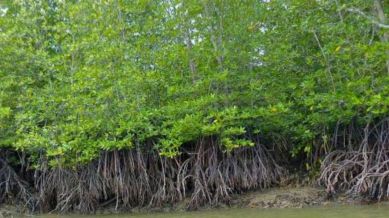Stay updated with the latest - Click here to follow us on Instagram
BMC proposes planting thrice the number of mangrove trees to be cut for Mumbai coastal road project
Civic officials said that in total, 60,000 mangrove trees will be affected for the project

To compensate for the loss of green cover in Mumbai, the Brihanmumbai Municipal Corporation (BMC) proposed planting thrice the number of mangrove trees that will be cut for the second phase of the Coastal Road project.
Alongside this, the civic authorities have also acquired land parcels in north Mumbai for setting up mangrove nurseries and is also mooting a proposal to acquire forest land at the Chandrapur district of Maharashtra.
monthly limit of free stories.
with an Express account.
On Monday, the civic authorities invited suggestions and objections from citizens after issuing a public notice stating that 9,000 mangrove trees will be cut for the coastal road project. Civic officials said that in total, 60,000 mangrove trees will be affected for the project.
“The project will require 102 hectare of land where a total of 60,000 mangrove trees are present, out of which only 9,000 trees will be cut for the purpose of constructing piers and pillars for an elevated road. The remaining 51,000 trees are falling in the influence zone area (IZA) which includes around the periphery of temporary structures that will be constructed, and the shadow of the upcoming bridge,” said an official privy to the project.
“Therefore, by following the environment norms we will be carrying out compensatory afforestation of three times the number of trees that will be felled for the project. As of today, we have finalised a 30-acre land parcel in Bhayander for this purpose. Besides this, we have also identified a land at Maharashtra’s Chandrapur, where compensatory afforestation will be carried out by us,” the official added.
The civic authorities had, in February, proposed setting up of mangrove nurseries between Versova and Dahisar and had also floated an Expression of Interest (EoI) for leasing land parcels from private owners for a period of 5-10 years, where such nurseries could be set up.
The civic officials maintained that till now they have received a response for one land parcel and the forest department is set to carry out a survey on the suitability of the land.
“Mangroves can’t be planted on any given land parcel. They require a specific kind of soil and salt levels. These assessments will be carried out by the forest department, following which it will be confirmed whether we can set up nurseries on those lands,” said the official.
The basic idea behind leasing these lands is to plant mangrove sapling on them, which will grow up to full grown mangroves within the period of a few years.
After that the grown mangroves could be transplanted in areas where there might have been a shortfall or may be allowed to grow on these nurseries depending on the nature of land.
For a coastal city like Mumbai, mangrove forests are vital ecosystems that act as natural buffers from coastal erosion, tidal flooding, storm surges, protecting shorelines and communities. The dense root systems stabilise sediments and reduce the impact of waves and current. The eastern and western shoreline of Mumbai has significant mangrove patches that are identified as mangrove zones.
However, with increased encroachment and infrastructure development, these patches have also recorded a reduction in its density in the past few decades.